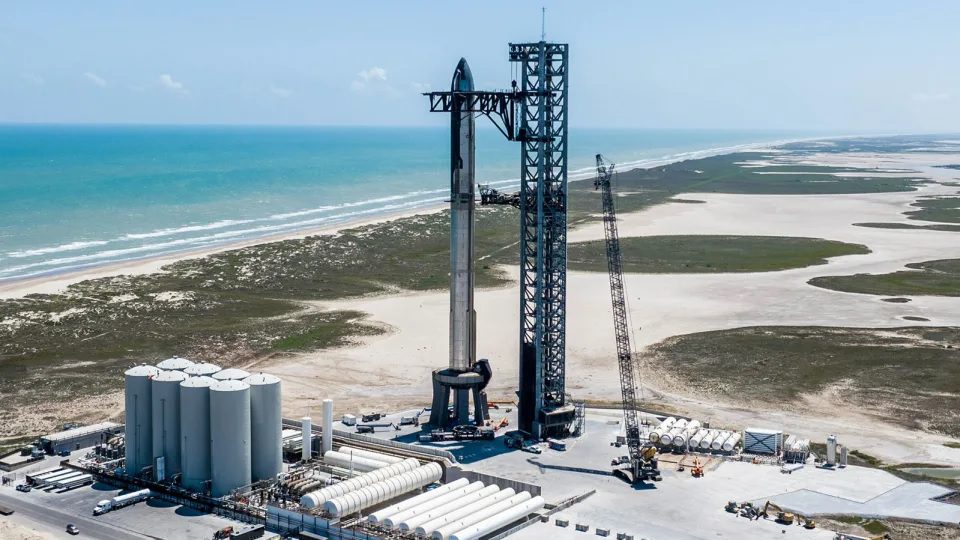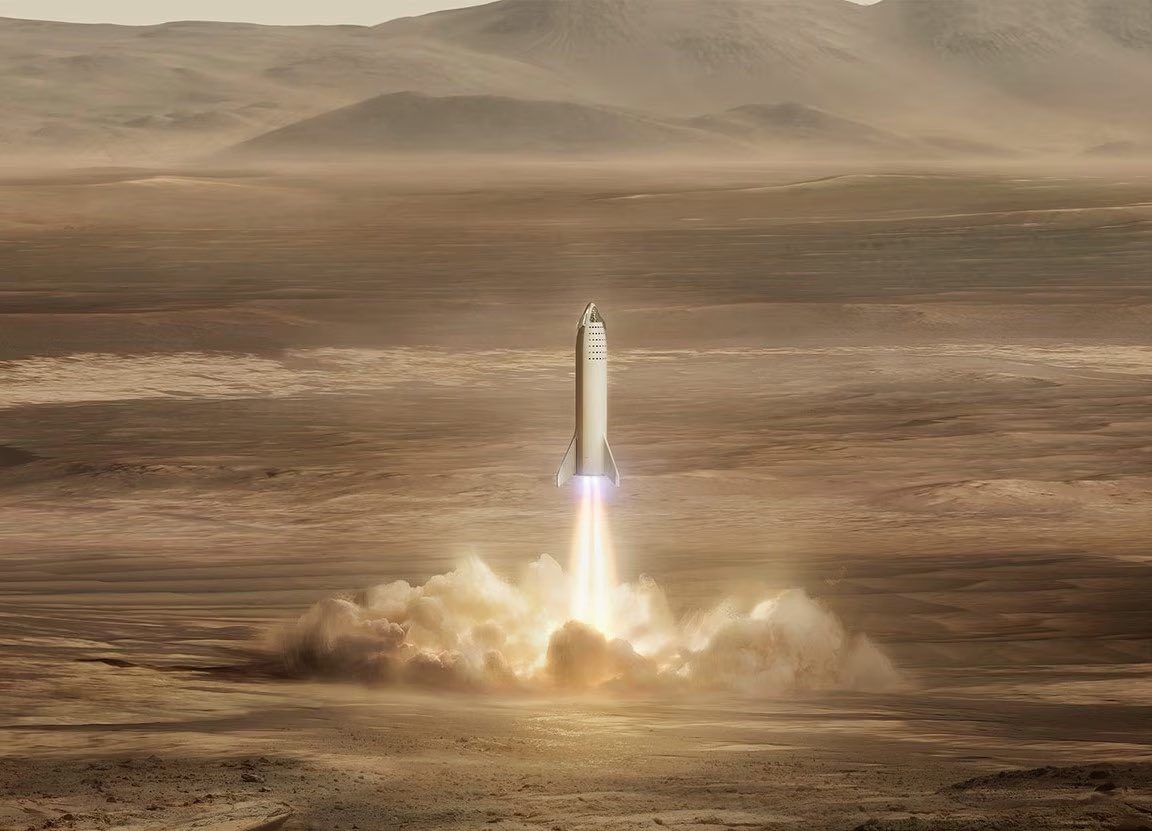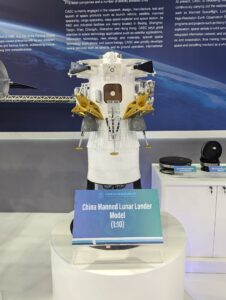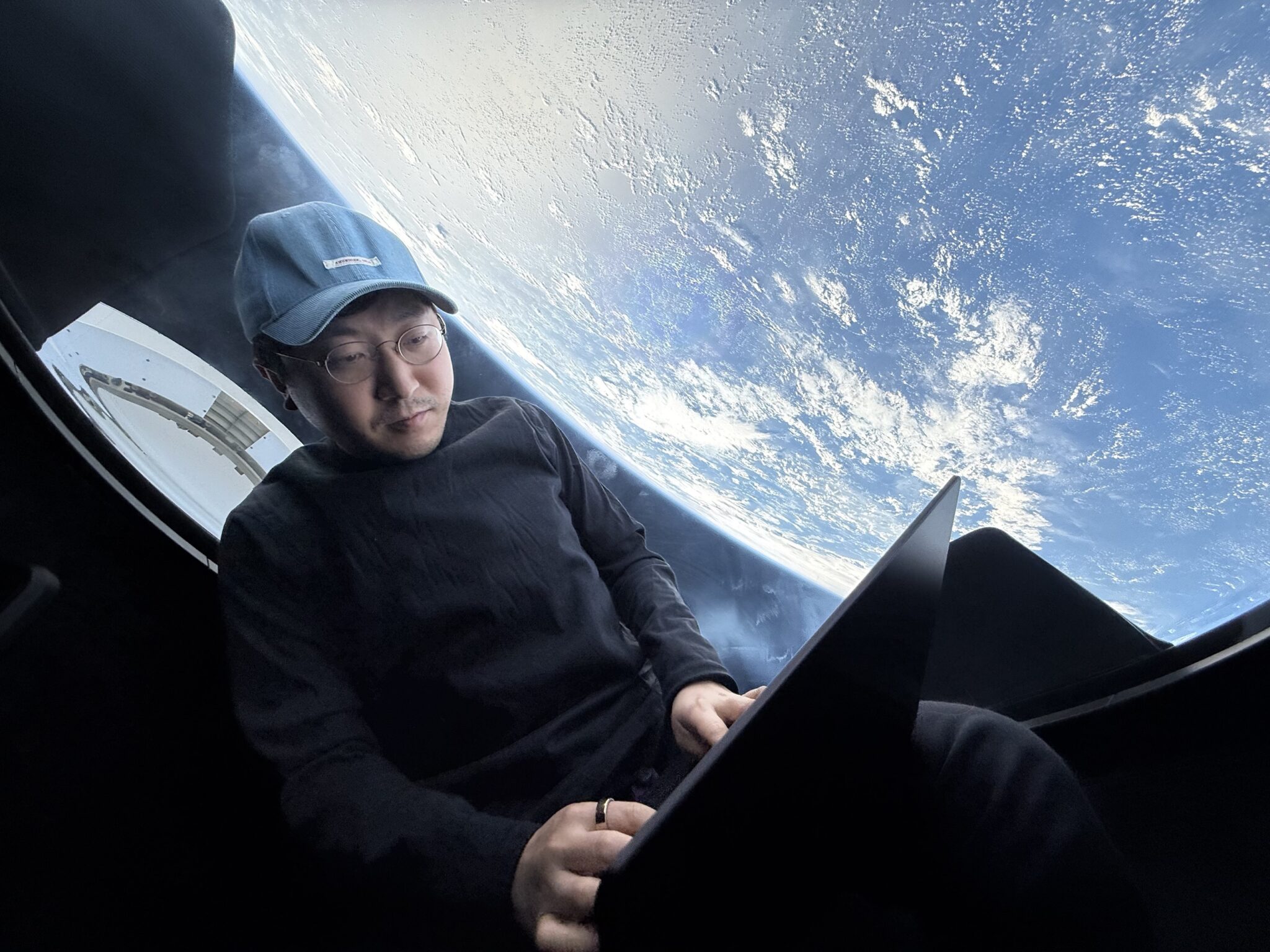Elon Musk’s virtual appearance at the International Astronautical Congress 2023 is dissected by Seradata Data Manager and reporter Matt Wilson, who did make it to Baku in-person.
Elon Musk, CEO and founder of SpaceX, made a remote appearance at the annual congress on 7 October after winning the International Astronautical Federation (IAF) World Space Award for spaceflight accomplishments, and to answer questions from long-time industry executive and IAF president Clay Mowry.

Elon Musk (online) talks to Clay Moury (seated) the International Astronautical Congress at IAC 2013 Baku. Courtesy: Seradata/Jon Freeman
After Starship’s in-flight failure earlier this year, the resumption of its test launch campaign has been a pressing issue for SpaceX. Musk confirmed that a second test flight is likely to occur in the next few months but he gave few other details about it. With a nonchalance and confidence that has come to define SpaceX, Musk said simply that “success is a possible outcome”.

Ready to go again: Super Booster/Starship combination awaits FAA go-ahead for its second orbital attempt. Courtesy: SpaceX
Rapid innovation is another SpaceX hallmark and we will see this in action on the second test flight with alterations to Starship. These include the move to a hot-staging design, used on Russian rockets Soyuz and Proton, that will see the upper stage ignite its engines before separation. The modification has been made for performance reasons and in light of the previous flight failure. Musk acknowledged it would probably be the riskiest part of the flight.
The flight plan will be similar to the first attempt, which should see the booster first stage end up in the Gulf of Mexico and the upper stage – which Musk referred to as “Ship” – almost complete an orbit before re-entering the atmosphere and performing a powered landing off the coast of Hawaii.
Rapid reuse is key – with Mars still the prize
Starship would have to fly regularly with “rapid reusability” to make long-range exploration, and its own operation, economically viable, according to Musk. His hope is that SpaceX will be able to make use of the “Mechazilla” – a chopstick-like pair of arms mechanism – at the launchpad to catch a returning Super Heavy first stage with perhaps an initial attempt next year.
He joked that it was inspired by the monster action film Godzilla vs Kong which features a mechanical, human-built, version of the legendary monster. While Musk accepted that conventional cranes could be used to assemble the Starship stack, he considered the Mechazilla an essential step on the road towards rapid and full reusability of the rocket. Although he acknowledged the technical risk of the catching attempt, he drily noted that: “Success is in the set of possibilities”.
Attempts at re-entering, landing and reusing the upper stage would then follow towards the end of next year. Musk accepted that reusing the upper stage would be the most revolutionary aspect of his new launch vehicle – and the trickiest to achieve. “Ship reusability is the hardest part of the equation,” he said.
Importantly, unlike the Falcon 9 first stage, which requires a few days of refurbishment between flights, there would be little or no refurbishment of either Starship stages in between its launches, dramatically increasing the flight rate. Interestingly, he hoped to raise the propellant loading on the upper stage to expand its share in achieving the required delta V (velocity change) to get into orbit. By allowing less to be carried by the Super Heavy stage, the burn time would be reduced to 100 seconds. This would enable a rapid return to the launch site, with the craft back on the pad and ready for relaunch within 45 minutes. Musk envisaged between four and five Starship launches per day. He accepted that he might need a third launch site – possibly sea-based –in addition to the ones in Boca Chica, Texas and in Florida (the latter of which has yet to be built).
Concerning intended uses of his huge 9 m diameter Starship, which even he describes as “ridiculously big”, on the mundane near-Earth side of his space business, Musk predicted that the new system could allow the launch of the larger third version of the Starlink satellites in “about a year from now”. Additionally, SpaceX is reportedly working with an astronomy team at the University of California, Berkeley, to scope out a mission plan for a space telescope with a 7-8 m diameter mirror making use of the spacious Starship fairing. For comparison, due to size restrictions when it was designed, the Hubble Space Telescope was limited to just a 2.4 m mirror.
As Elon Musk has said before, Starship has been designed with the intention of facilitating permanent settlement of humans on another planet (like Mars) and for the exploration of the solar system. During his talk, he indicated that these aims had guided the size of Starship.
He and his engineers have calculated that in order to support a Martian settlement (of uncertain size), one million metric tons of cargo will be required on the planet’s surface. And that means launching five million metric tons of mass into low Earth orbit (LEO). Even with the reported 150 metric tons to LEO capability of a fully reusable Starship – itself an impressive feat – that will take a long time to prepare. As an example, Musk noted that Falcon rockets currently launch about 80 per cent of the cargo to orbit, and they only carry 1,600 metric tons per year. This would have to rise to hundreds of thousands of metric tons per year.
When asked when the first Mars mission would be, Musk predicted that SpaceX would be able to conduct an unmanned Starship landing mission on Mars in 3-4 years, depending on Earth-Mars orbit synchronisation. Musk is, however, known for his optimistic forecasting.

Artist’s impression of Mars lift off by Starship. Courtesy: SpaceX
To get five million tons to LEO, SpaceX will have to advance its rapid reusability capabilities, but it will also need a large number of Starship rockets to conduct all of these launches. Recognising this need, SpaceX is building a dedicated Starship construction facility at its Boca Chica, Texas, spaceport (which it refers to as Starbase). Currently the rocket’s Raptor engines are still built in the SpaceX headquarters in California. Additionally, in its quest for more launches, SpaceX is converting the Launch Complex 39A site at the Kennedy Space Center, Florida, to accommodate Starship. Previously this pad was used for Falcon Heavy missions.
Unfortunately, Musk was not questioned about how a non-blunt body like Starship would be able to make a super-hot re-entry on interplanetary missions at super-orbital speeds, or whether such vehicles would have to be propulsively slowed down first.
Lunar Spaceflight
Some have expressed concern about the progress of SpaceX’s lunar lander programme as part of its NASA Human Landing System (HLS) contract, and its cryogenic refuelling technology. Musk, however, seemed unperturbed. Explaining that the spacecraft has a propulsive landing system enabling it to land anywhere in the solar system, he did not think that the hardware to land on the Moon would be significantly different from the standard version. With respect to achieving dockings for cryogenic fuel transfer, Musk posited that dockings between Starships would be easier than those with the ISS and envisaged having a specialist tanker version with extended propellant tanks. He made no comment about the actual transfer technology or cryogenic storage.
Musk mused that Tesla, another of his business ventures, was ideally placed to provide a Moon rover vehicle. Customers might even be able to order a “Moon Option Package” on a Tesla car one day. Although this was said in jest, perhaps it is not so outlandish a prospect for the entrepreneur shaking up both the space and automotive industries.
Other Starship Applications
It has been mooted that the upper stage of Starship might be converted into a space station. Musk agreed – he believes that its 1,000 cubic metre empty internal volume exceeds that of the ISS.
Starship would be able to reduce typical aircraft journey time of 14 hours to just 30 minutes. As to whether long distance travel applications on Earth would be economical, Musk pointed out possible cost savings from the absence of crew as food, bathrooms and other facilities would not be needed.
While Starlink threatens to take over the satellite communications business on Earth, Musk was asked about its potential to explore Mars. He responded that some sort of space-based communications relay system would be needed for Mars, probably involving laser communications due to the Sun getting in the way.
Musk appeared unmoved by recent news stories about alien life. Instead, the entrepreneur has felt a growing realisation that the human species might be the only life in the universe. His drive to make humans an interplanetary species has been its survivability. “Don’t let the [human] candle to go out,” he warned his audience.
Comment on IAC 2023 Baku:

Latest artist impressions of the Starship based HLS lander. Courtesy: SpaceX
Overall the IAC 2023 Baku was regarded by attendees as a well-organised success with several very interesting plenary and technical sessions. While disappointing the audience in being online only, the appearance of Elon Musk was a crowd pleaser, even though he was not asked some key questions on the progress of the Starship-based lunar lander. It was interesting that the IAC’s exhibition had a number of interesting exhibits – especially from China – including a model of its proposed human lunar lander which is not expected to use cryogenic propulsion.
However, despite the success of IAC 2023 Baku, Seradata feels unable to provide its usual full report on the Congress after IAC 2023/Azercosmos’ decision not to award Seradata Space Intelligence reporters full media accreditation – the first time this has happened to us at the IAC.
Nevertheless, we will make one observation. At the opening ceremony, Ilham Aliyev, President of Azerbaijan, noted space cooperation but also used part of his Congress-opening speech to defend Azerbaijan‘s recent military operation in Nagorno-Karabakh which cleared the region of Armenian rebel forces and led to most of the Armenian populace fleeing the region. While President Aliyev made a strong and eloquent defence of this controversial military operation, this part of his speech was seen by most as inappropriate at an event which is supposed to be about peaceful cooperation in space. This is not the first time that the IAC welcoming speech has been misused. At IAC 2019 Washington, the then US Vice President Mike Pence caused similar controversy when he made his speech too much about about US space leadership and the Trump administration’s “America First” stance. As would be expected, this did not go down well with the mainly international space audience.

A model of the proposed Chinese lunar lander was on display at IAC 2023 Baku. Courtesy: Seradata/Jon Freeman
Matt Wilson reported from Baku. David Todd contributed to this report from London.







